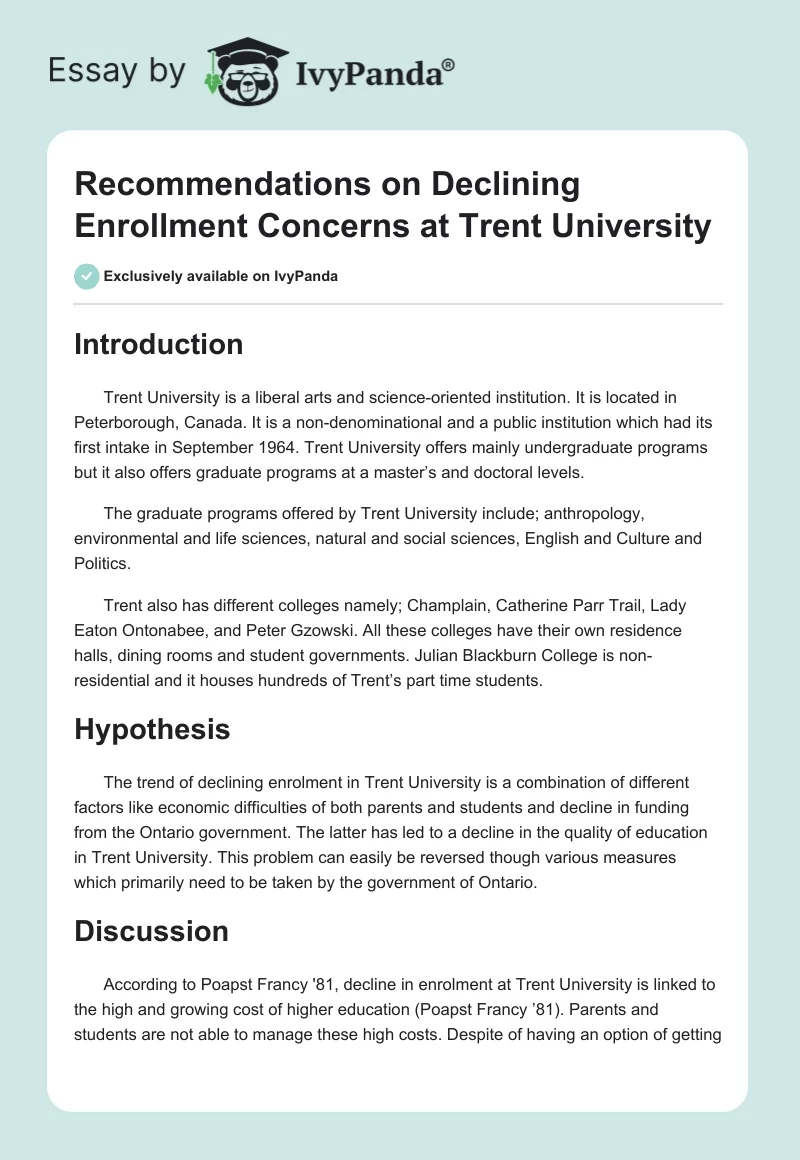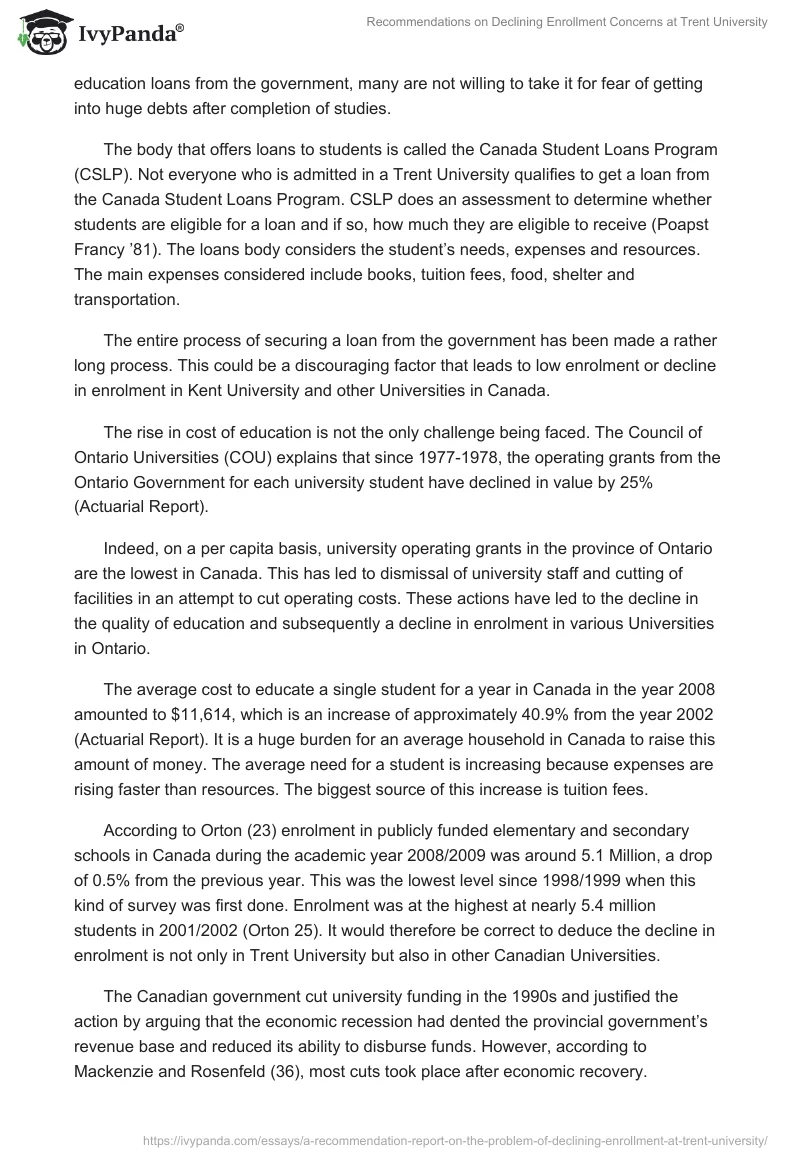Introduction
Trent University is a liberal arts and science-oriented institution. It is located in Peterborough, Canada. It is a non-denominational and a public institution which had its first intake in September 1964. Trent University offers mainly undergraduate programs but it also offers graduate programs at a master’s and doctoral levels.
The graduate programs offered by Trent University include; anthropology, environmental and life sciences, natural and social sciences, English and Culture and Politics.
Trent also has different colleges namely; Champlain, Catherine Parr Trail, Lady Eaton Ontonabee, and Peter Gzowski. All these colleges have their own residence halls, dining rooms and student governments. Julian Blackburn College is non- residential and it houses hundreds of Trent’s part time students.
Hypothesis
The trend of declining enrolment in Trent University is a combination of different factors like economic difficulties of both parents and students and decline in funding from the Ontario government. The latter has led to a decline in the quality of education in Trent University. This problem can easily be reversed though various measures which primarily need to be taken by the government of Ontario.
Discussion
According to Poapst Francy ’81, decline in enrolment at Trent University is linked to the high and growing cost of higher education (Poapst Francy ’81). Parents and students are not able to manage these high costs. Despite of having an option of getting education loans from the government, many are not willing to take it for fear of getting into huge debts after completion of studies.
The body that offers loans to students is called the Canada Student Loans Program (CSLP). Not everyone who is admitted in a Trent University qualifies to get a loan from the Canada Student Loans Program. CSLP does an assessment to determine whether students are eligible for a loan and if so, how much they are eligible to receive (Poapst Francy ’81). The loans body considers the student’s needs, expenses and resources. The main expenses considered include books, tuition fees, food, shelter and transportation.
The entire process of securing a loan from the government has been made a rather long process. This could be a discouraging factor that leads to low enrolment or decline in enrolment in Kent University and other Universities in Canada.
The rise in cost of education is not the only challenge being faced. The Council of Ontario Universities (COU) explains that since 1977-1978, the operating grants from the Ontario Government for each university student have declined in value by 25% (Actuarial Report).
Indeed, on a per capita basis, university operating grants in the province of Ontario are the lowest in Canada. This has led to dismissal of university staff and cutting of facilities in an attempt to cut operating costs. These actions have led to the decline in the quality of education and subsequently a decline in enrolment in various Universities in Ontario.
The average cost to educate a single student for a year in Canada in the year 2008 amounted to $11,614, which is an increase of approximately 40.9% from the year 2002 (Actuarial Report). It is a huge burden for an average household in Canada to raise this amount of money. The average need for a student is increasing because expenses are rising faster than resources. The biggest source of this increase is tuition fees.
According to Orton (23) enrolment in publicly funded elementary and secondary schools in Canada during the academic year 2008/2009 was around 5.1 Million, a drop of 0.5% from the previous year. This was the lowest level since 1998/1999 when this kind of survey was first done. Enrolment was at the highest at nearly 5.4 million students in 2001/2002 (Orton 25). It would therefore be correct to deduce the decline in enrolment is not only in Trent University but also in other Canadian Universities.
The Canadian government cut university funding in the 1990s and justified the action by arguing that the economic recession had dented the provincial government’s revenue base and reduced its ability to disburse funds. However, according to Mackenzie and Rosenfeld (36), most cuts took place after economic recovery.
Trent and other universities in Ontario have responded to these cuts in public support for higher education by raising student tuition and fees as well as by increasing their reliance on private contracts and donations from wealthy corporations and individuals to fund their operations. Canadian government has seen university funding cutback as an easy target, whenever they feel strain to reduce their spending, not considering whether the pressure is based on the need to pay for tax cuts a weak economy (Mackenzie and Rosenfeld 44).
The government dependence on tuition increases suggests that, up to now, it believes that it can get away with daunting the weight of their cuts on students and families who are mostly from the middle class group in the society. This is seen as mainly political and it takes advantage of the students and families.
It would however be unfair to say that the government is not doing anything concerning the decline in enrolment in Trent University. The government gives parents the Registered Education Saving plan (RESP) which helps the parents to save towards the higher education of their children. A survey done in Ontario by Mackenzie and Rosenfeld (51) publicized significant support for provincial re-investment in the tertiary education system as indicated below.
- 81% would support a boost of the government-sponsored student grant program.
- 78% would support increased government funding of institutions of higher learning, while only 15% have the differing view.
- 91% of parents with high school kids support increased government funding of tertiary/Higher education.
- 81% of those interviewed support the employment of more full-time faculty members.
- 81% would support increased government funding to solve the problem of faculty shortage.
- 79% would support the extension of the government-sponsored student loan program.
- 86% of Ontario residents support lowering tuition fees in order to improve the access to University education in Ontario.
Recommendations
From the research, I would suggest the following recommendations:
Operating grants to the university should be increased. This should be primarily from the government as opposed to rich individuals and corporations. The government should take advantage of the economic recovery and increase its funding to the University.
A faster and transparent way of giving education loans to students should be devised and students should be encouraged to apply for those loans (Adler et al 44). The interest rates for paying back the loans, which are also a discouraging factor, should be reviewed and significantly reduced.
As the government heads to full economic recovery and growth, it should put more emphasis on tertiary/ university education. Public awareness on the availability of funds (Loans) should be done, especially in secondary schools. This can also be done through the media. This will consequently counter the decline in enrolment in Trent University and other Universities in Canada (Adler et al 36).
After the government increases its grants to the university, a body should be formed to regulate the tuition fees in the university. This will curb a trend that has emerged where Ontario Universities do not admit students based on quality of the institution but on the wealth of the graduates as well as the attractiveness of the programs.
The government of Canada can make use of funds from the Canada Health Transfer (CHT) and Canada Education Savings Grant (CESP) to fund higher institutions. Other sources of funding that students and parents can make use of include Canadian student loans, Canada Millennium Scholarship Foundation (CMSF) and Ontario Graduate scholarship.
Conclusion
There is generally a decline in enrolment in the Trent University in Peterborough, Canada. This is combination of different factors, the chief one being a high cost of University education. The government has a big part to play in the quest to reverse this trend and to ensure that the University of Trent and other Universities are not financially crippled.
This could be through increasing the operating grants to Kent University and giving more funding to students in form of education loans. Dependence on tuition to make up for funding shortfalls has imposed an extremely enormous burden on students.
The Economic situation as a whole has also led to decline in enrolments in the university. A progressive effort to improve the economy would see more enrolments taking place in the University of Trent. With a large number of high school graduates waiting to join the higher education system, the above recommendations should be quickly and efficiently effected.
Works Cited
Actuarial Report. Canada Student Loans Program, 2007. Web.
Adler, Ronald B, Rodman George R and Sévigny Alexandre. Understanding Human Communication, 2011. Print.
Mackenzie, Hugh and Rosenfeld Mark. University Funding Cuts: Short-changing Ontario Students. Ottawa: Canadian Centre for Policy Alternative, 2002.
Orton, Larry. A New Understanding of Postsecondary Education in Canada: A Discussion Paper. Ottawa: Culture and the Centre for Education Statistics Division, 2001. Print.
Poapst, Francy ’81. Higher Education Costs. 1995. Web.


